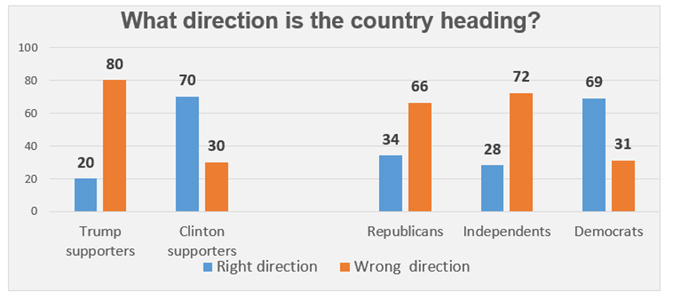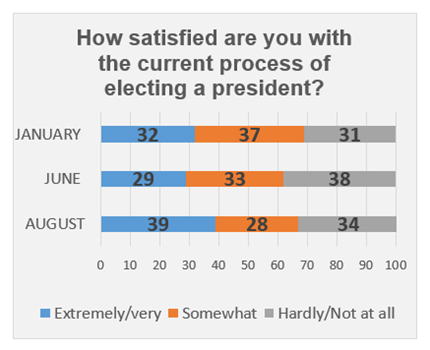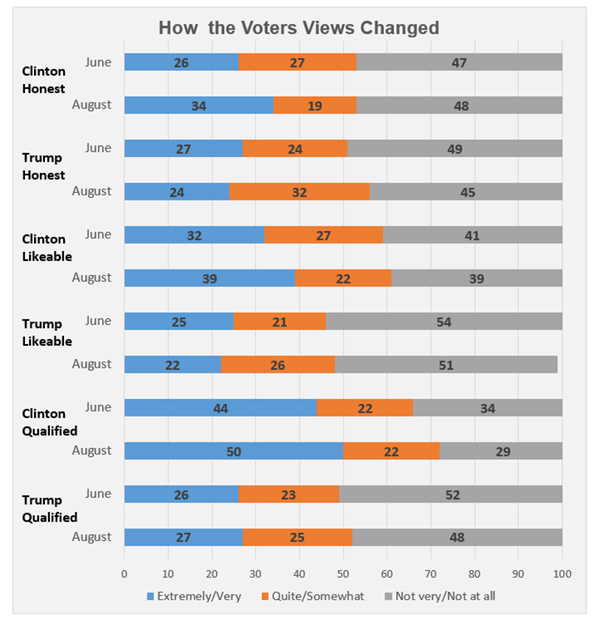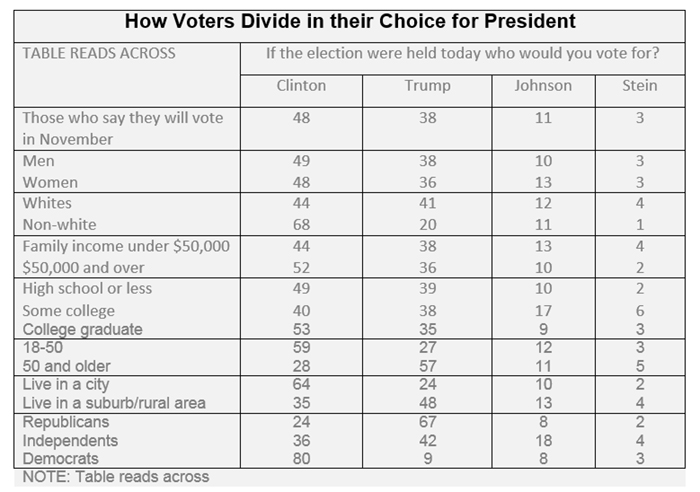Election 2016 – Post-Convention: Heading Toward the Home Stretch before Labor Day
9/8/2016
Now that the Republican and Democratic candidates have been officially chosen for the 2016 presidential election, the latest national poll from the Fishlinger Center for Public Policy Research at the University of Mount Saint Vincent finds fewer voters are unhappy with the process. And while most voters continue to say the country is headed in the wrong direction, that number has dropped from 60 percent to 54 percent.
The Fishlinger Center for Public Policy Research at the University of Mount Saint Vincent seeks to foster meaningful dialog on key public policy issues through independent, objective public opinion research. The national surveys of 2016 will focus on political issues in the United States ahead of the Presidential election in November.
Before the start of the primaries, the Fishlinger Center conducted an online poll January 4 to 25, 2016 with 1,000 adults nationwide, of whom 912 said they were registered or planned to register to vote. The second poll was conducted June 8 to July 5 with 1,000 adults nationwide, of whom 845 said they planned to vote in the presidential election in November. After the Republican and Democratic conventions, a third poll was conducted Aug. 15 to Sept. 1 with 514 adults nationwide, of whom 453 said they were likely to vote in November.
Mrs. Clinton has been confronted by a new round of questions about potential conflicts of interest about her family’s foundation and her work at the State Department as well as the prospect that more e-mails from her private account will be released right up to the November election. However, Mr. Trump has not been able as yet to capitalize on these problems with the Clinton campaign and continues to trail Mrs. Clinton in the Fishlinger Poll as well as in the Real Clear Politics national average.
Among those who say they plan to vote in November, 48 percent prefer Mrs. Clinton and 37 percent support Mr. Trump. Gary Johnson, the Libertarian candidate, is backed by 11 percent of the voters. In order to be included in the presidential debates, a candidate needs to receive an average of 15 percent in the ABC News/Washington Post, New York Times/CBS News, CNN, Fox News and NBC News/Wall Street Journal polls. The Green Party candidate, Jill Stein, received 3 percent.
State of the Country
There continue to be substantial partisan differences in views of how the country is doing. Most Democratic voters regard the country as headed in the right direction, while Republicans and independents say the country is moving in the wrong direction. In the same way, voters who expect to vote for Mrs. Clinton see the United States moving in a positive course, while those who say they will vote for Mr. Trump say the country is headed in the wrong direction.

Views of the campaign
 The months of candidate speech-making, political advertising, and party conventions has done little to change voters’ views of the country’s election process.
The months of candidate speech-making, political advertising, and party conventions has done little to change voters’ views of the country’s election process.
Voters were slightly more negative in June compared with the results of the poll taken in January before any primaries were held. And now after the conventions, they are slightly more satisfied.
Perceptions of the Candidates
Voters’ impressions of Mrs. Clinton have improved since the conventions, while the opinions of Mr. Trump have stayed pretty much the same. Mrs. Clinton is seen as even more qualified and better able to deal with foreign and domestic policy than she was in June. Neither candidate is viewed as particularly honest or likeable.
Of course, again there are large partisan differences. For example, 55 percent of Democrats consider Mrs. Clinton extremely well qualified, compared with 20 percent of Republicans and 22 percent of independents. Republicans are not quite as confident about their party’s presumptive nominee. Only 24 percent of Republicans describe Mr. Trump as extremely well qualified, along with 6 percent of Democrats and 8 percent of independents.

Profiles of the Candidates’ Supporters
Mrs. Clinton does best with better educated and more affluent voters. Non-whites and urban voters are more inclined to support her, as are younger voters. Mr. Trump is preferred by older voters and those living outside cities. White voters are closely divided, as are independents.
Gary Johnson, the Libertarian candidate, does best with independents and voters who say they have some college. Those voters may currently be students.
Jill Stein, the nominee of the Green Party, is getting about 3 percent of the vote largely from those who say Bernie Sanders was their first choice back in January.

Survey Methodology
The fieldwork for the Fishlinger Center Poll was conducted using a blended national Survey Sampling Inc. panel. Online interviews were conducted with 912 adults who reported they are registered or plan to register to vote January 4 to 25, with 845 adults who said they plan to vote in the presidential election interviewed online June 8 to July 5, and with 453 adults who said they plan to vote in November interviewed August 15 to September 1.
The first and second surveys have a credibility interval of plus or minus 4.0 percentage points for those who plan to vote in November; the credibility interval for the third survey is plus or minus 4.5 percentage points. The credibility interval may be larger for other sub-groups. The polls are subject to other potential sources of error including, but not limited to coverage and measurement error. Data were rim weighted to match the national population on age, sex, Hispanic origin and race. Question wording and topline results are available at fishlingercenter@mountsaintvincent.edu.
About the Fishlinger Center for Public Policy
The Fishlinger Center for Public Policy Research opened in February 2015 at the University of Mount Saint Vincent. The Center, a member of the American Association for Public Opinion Research (AAPOR), conducts deep and broad studies of public opinion on key public policy concerns through independent and objective research conducted by students, faculty, and other members of the academic community.
By providing a forum for discourse that can stimulate intelligent dialog about issues that deeply affect all Americans, the Center illustrates and enhances the relationship between the work of the College and the common good.
About the University of Mount Saint Vincent
Founded in 1847 by the Sisters of Charity, the University of Mount Saint Vincent offers nationally recognized liberal arts education and a select array of professional fields of study on a landmark campus overlooking the Hudson River. Committed to the education of the whole person, and enriched by the unparalleled cultural, educational and career opportunities of New York City, the College equips students with the knowledge, skills and experiences necessary for lives of achievement, professional accomplishment and leadership in the 21st century.
